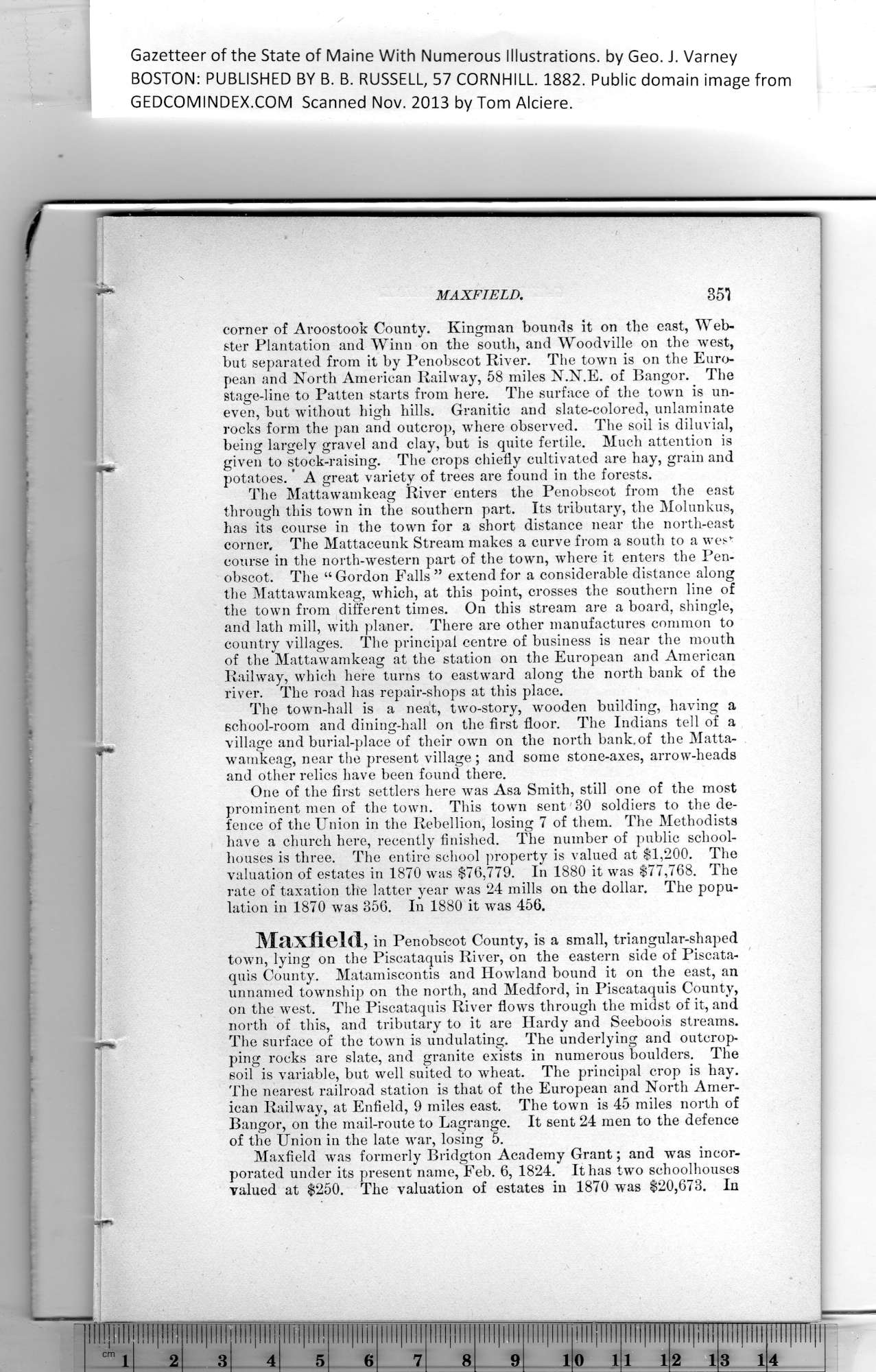|
Gazetteer of the State of Maine With Numerous Illustrations, by Geo. J. Varney
BOSTON: PUBLISHED BY B. B. RUSSELL, 57 CORNHILL. 1882. Public domain image from
MAXFIELD. 351
corner of Aroostook County. Kingman bounds it on the east, Web-
ster Plantation and Winn on the south, and Woodville on the west,
but separated from it by Penobscot River. The town is on the Euro
pean and North American Railway, 58 miles N.N.E. of Bangor. The
stage-line to Patten starts from here. The surface of the town is un-
even, but without high hills. Granitic and slate-colored, unlaminate
rocks form the pan and outcrop, where observed. The soil is diluvial,
being largely gravel and clay, but is quite fertile. Much attention is
given to stock-raising. The crops chiefly cultivated are hay, grain and
potatoes. ’ A great variety of trees are found in the forests.
The Mattawamkeag River enters the Penobscot from the east
through this town in the southern part. Its tributary, the Molunkus,
has its course in the town for a short distance near tbe north-east
corner. The Mattaceunk Stream makes a curve from a south to a wes*
course in the north-western part of the town, where it enters the Pen-
obscot. The “Gordon Falls ” extend for a considerable distance along
the Mattawamkeag, which, at this point, crosses the southern line of
the town from different times. On this stream are a board, shingle,
and lath mill, with planer. There are other manufactures common to
country villages. The principal centre of business is near the mouth
of the Mattawamkeag at the station on the European and American
Railway, which here turns to eastward along the north bank of the
river. The road has repair-shops at this place.
The town-hall is a neat, two-story, wooden building, having a
school-room and dining-hall on the first floor. The Indians tell of a
village and burial-place of their own on the north bank.of the Matta-
wamkeag, near the present village ; and some stone-axes, arrow-heads
and other relics have been found there.
One of the first settlers here was Asa Smith, still one of the most
prominent men of the town. This town sent 30 soldiers to the de-
fence of the Union in the Rebellion, losing 7 of them. The Methodists
have a church here, recently finished. The number of public school-
houses is three. The entire school property is valued at $1,200. The
valuation of estates in 1870 was $76,779. In 1880 it was $77,768. The
rate of taxation the latter year was 24 mills on the dollar. The popu-
lation in 1870 was 356. In 1880 it was 456.
Maxfield, in Penobscot County, is a small, triangular-shaped
town, lying on the Piscataquis River, on the eastern side of Piscata-
quis County. Matamiscontis and Howland bound it on the east, an
unnamed township on the north, and Medford, in Piscataquis County,
on the west. The Piscataquis River flows through the midst of it, and
north of this, and tributary to it are Hardy and Seeboois streams.
The surface of the town is undulating. The underlying and outcrop-
ping rocks are slate, and granite exists in numerous boulders. The
soil is variable, but well suited to wheat. The principal crop is hay.
The nearest railroad station is that of the European and North Amer-
ican Railway, at Enfield, 9 miles east. The town is 45 miles north of
Bangor, on the mail-route to Lagrange. It sent 24 men to the defence
of the Union in the late war, losing 5.
Maxfield was formerly Bridgton Academy Grant; and was incor-
porated under its present name, Feb. 6, 1824. It has two schoolhouses
valued at $250. The valuation of estates in 1870 was $20,673. In
PREVIOUS PAGE ... NEXT PAGE
This page was written in HTML using a program written in Python 3.2
|
